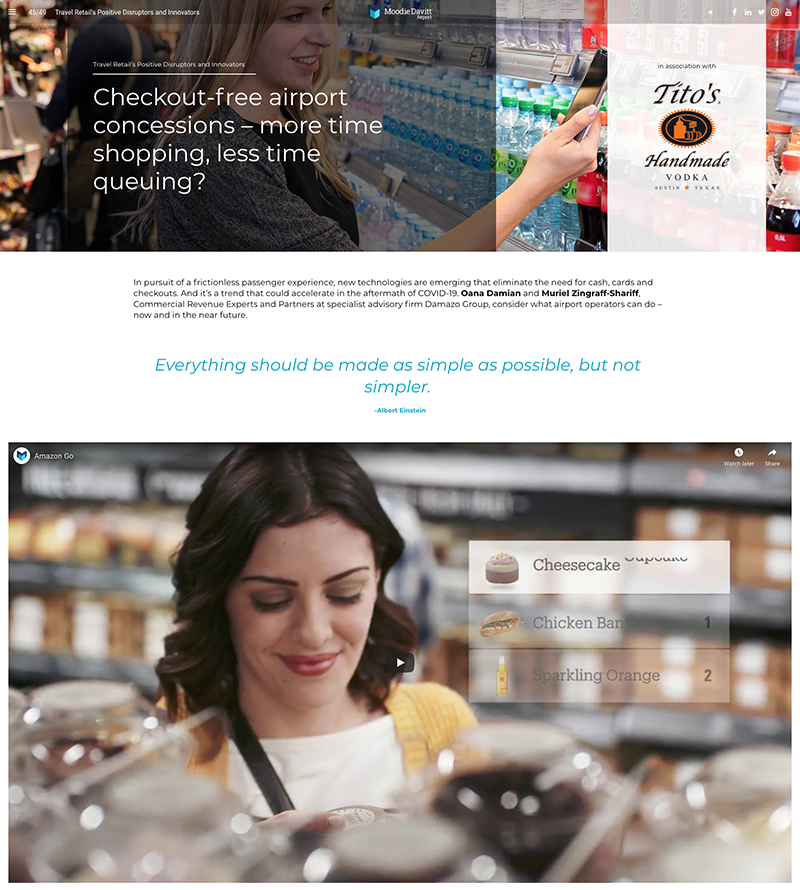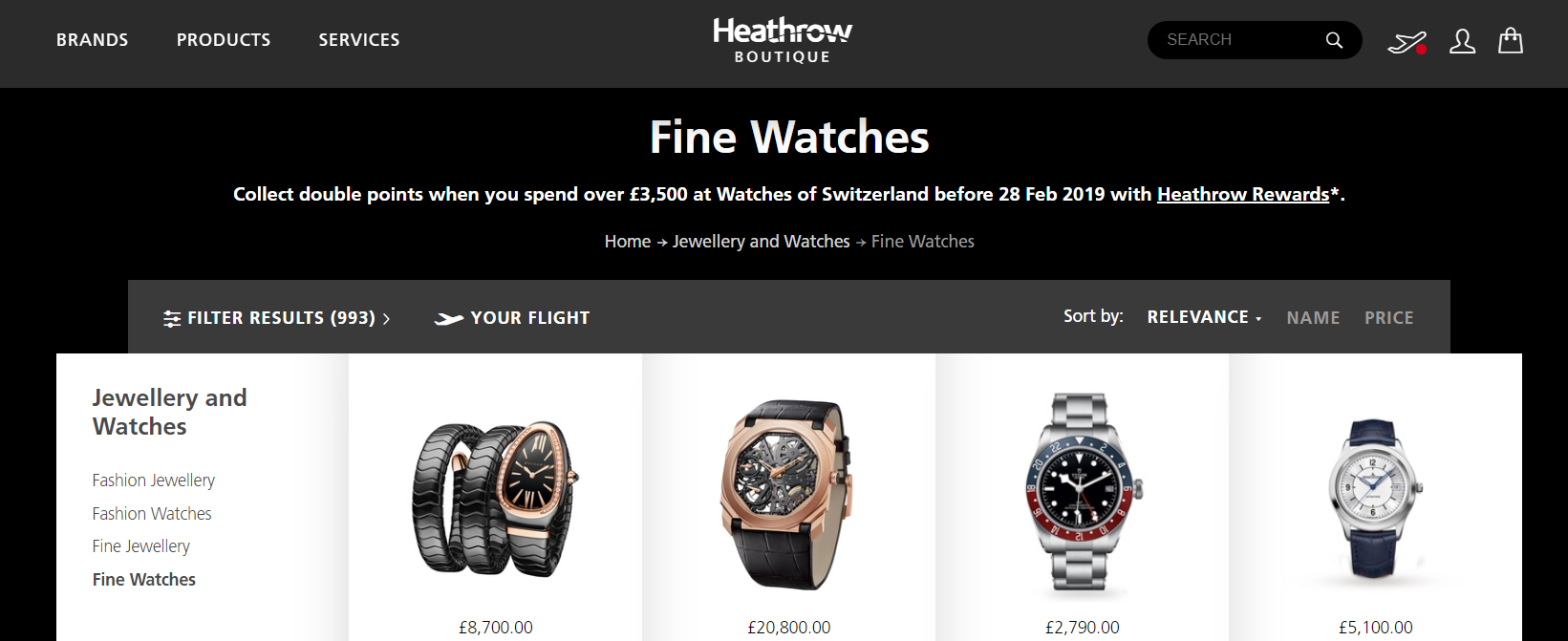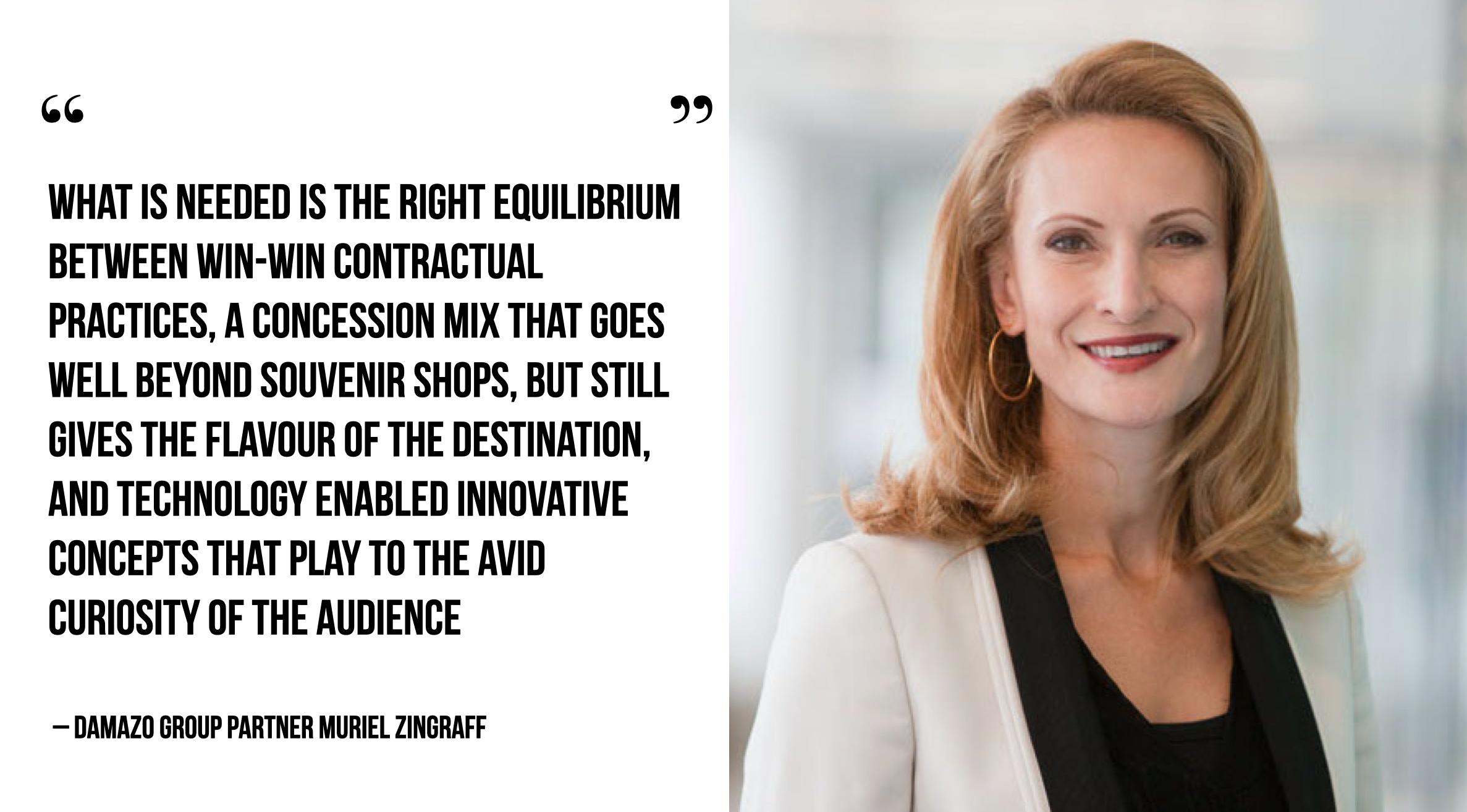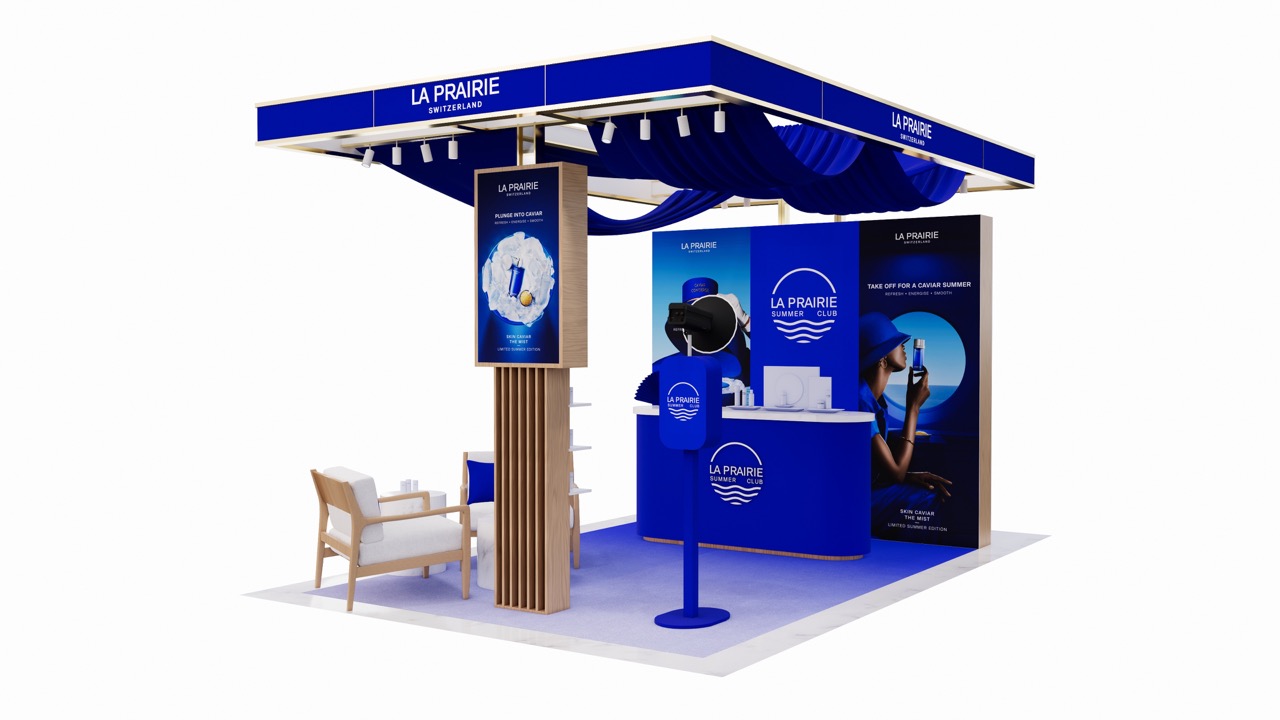
Publisher’s introduction: Damazo Group founder Oana Damian (top left) and Partner in the business Muriel Zingraff (right, a former Retail Concessions Director at Heathrow Airport between 2011 and 2014), who also runs her own firm, MZS Consulting, have combined to offer their considerable experience to transform the retail performance and concession planning of some of the world’s biggest airports.
Here, they give The Moodie Davitt Report a fascinating insight into their ‘Retail Vision’ service, what inspires them and why they are undaunted about the industry effects of COVID-19. They also offer some must-read opinions on the future of airport retail.
The Moodie Davitt Report: Oana, can you tell us about the Damazo Group – what are the origins of the business and its mission?

Oana Damian: I founded Damazo Group in 2017 as a specialised consulting firm which sits at the intersection of airport infrastructure and travel technology innovations. This is what sets us apart from industry peers. With 68% of the world population now owning a mobile device, up from 53% in 2017, it is clear that the modus operandi has shifted.
This is just one example of how technology has changed the world as we once knew it. This significant shift is reflected in all areas of airport operations, and our mission is to work with airport operators to understand, develop and implement transformational ways of delivering additional revenue to the bottom line, particularly on the non-aeronautical front.
Where did the company name come from?
Damazo is the Greek origin of my surname Damian. The original word, damianos, comes from damazo, which means “to master”. We master airport commercial revenue – all facets of it – based on expertise developed over almost a decade, across most international markets. We have been providing advisory services to airports, government and financial institutions in the areas of commercial due diligence, business planning, airport commercial planning and transactions/PPPs worldwide.
In addition, our innovative proprietary tool Retail Vision enables us to work with airport operators in defining and capturing the optimum tenant selection, based on a precise matching of passenger profiles and the integration of shopping trends and societal changes.
When did the two of you start working together and how did that come about?

Muriel Zingraff: We started working together over a year ago, when we were introduced by Peter Millard from Harling Menzies – Peter and I had collaborated at Heathrow, helping me recruit some key members of my team. He thought our expertise, experiences and personalities were complementary and that we should get to know each other.
Oana Damian:We first met at 5 Hertford Street [a private members’ club] in London, and from the first cup of tea we knew we’d make a great team. The more we talked, we realised how well our experience and expertise would be of help to airport operators. I invited Muriel to become a Partner at Damazo.
Muriel knew retail inside out, and specifically airport retail after having led the commercial team at London Heathrow. I had worked on airport projects worldwide, from transactions, to commercial development and business plan reviews. We both had a passion for technology and innovation. In addition, out of the six languages I speak, French has the least proficiency – and French is Muriel’s mother tongue – so we’ve got almost all world regions covered.
Sum up your company philosophy and tell us what makes you stand out from the consultancy crowd.
Oana Damian: We want airports to gain or enhance their position as destinations in their own right – both as a means to commercial profitability and favourable passenger engagement. Our approach has a forward-looking edge; we see passengers as people with well-contoured individualities, a high degree of awareness and tech savviness, and high expectations in terms of service and offerings.
A new set of Lego may not be as attractive in the airport retail context, if Amazon offers it for a lower price and same-day delivery, but a Lego-branded children’s play area – experiential retail – which relieves the difficulties of travelling with children, may play favourably on the passenger engagement side, and generate extra returns for the airport.
On the other side, Muriel has worked extensively with brands and commercial real-estate companies, so she knows exactly what brands are looking for, and how to establish the perfect win-win agreement to benefit the airport, the brand, and the passengers.
All of this captures a new dimension and high relevance in the current world context, defined by a sweeping pandemic, in which the status quo is challenged. To come out of this and into a full recovery, the airports will need support in rethinking and redesigning commercial offerings that appeal to the millions of passengers who will eventually start travelling again. But will they have the same mindset, the same shopping behaviour?

You say you sit at the intersection of airport infrastructure and travel technology innovations. Can you explain further?
Oana Damian: While commercial due diligence and concession development in the traditional sense are both exciting, we view numbers and locations contextually, through the technological innovation lens. In addition to what I previously mentioned, we should point out that our experience draws from airport consultancy and operation, as well as high street retail, luxury retail, and travel technology.
We have the understanding, the passion, and the curiosity to evaluate innovation trends and make parallels within the airport environment. We take a kaleidoscope view on consumer behaviour, and go deep into the multiple facets of their motivations, expectations, and distractions – technology plays an important role in the latter.
Muriel Zingraff: I would add that we cover the brand perspective as well. Well-known brands, bricks and mortar or online, have interest in gaining from the visibility conferred within the airport environment. Airports want to diversify and increase the relevance of their offering. Passengers want seamless, shareable airport experiences, and retail can play a great role in creating these. So the interaction of airport-brand-passenger becomes the space where creativity, business and technology fit perfectly together.

Can you highlight some case studies?
Muriel Zingraff: The innovative remodelling of the South End of Terminal 5 at London Heathrow Airport led to the opening of the first Louis Vuitton Duty Free store in Europe and attracted the top luxury brands to the terminal such as Chanel, Rolex and Fortnum & Mason. It has generated double digit growth in revenue for Heathrow since 2014.
Oana Damian: The privatisation of the Brazilian airports, Rio Galeão and Confins, as well as several subsequent rounds, represents a successful model of PPPs in emerging markets, and must be one of my all-time most favourite transaction projects.

The main learning is that inefficiencies can be turned upside down and converted to opportunities, with the right expertise, team and dedication. What Dufry has done at Rio de Janeiro International Airport in terms of the duty free concepts and offering is impressive – a sleek and engaging representation of the Brazilian setting, creating a long-lasting Sense of Place, which in turn translates into increasing revenue and passenger satisfaction.
The same movement is now taking place in the Asia Pacific region, with Indonesia, Thailand, and the Philippines looking at international airport operator partners to come onboard and bring their expertise to respond efficiently and profitably to the forecasted high growth in air traffic demand. More so, the APAC region calls for innovative thinking, given the expectations of a tech savvy audience, as well as the standards set by the highest-ranked airports such as Changi, Incheon and Narita in terms of offerings and operational efficiencies.
The main learning from a commercial revenue perspective is that high-volume passenger traffic and in some cases, reliance on high Minimum Annual Guarantees, is certainly not enough to make up the numbers. What is needed is the right equilibrium between win-win contractual practices, a concession mix that goes well beyond souvenir shops, but still gives the flavour of the destination, and technology enabled innovative concepts that play to the avid curiosity of the audience. All of these have to be carefully designed, with one word in mind: seamless.
Muriel, you created a proprietary tool, Retail Vision, designed to capture the optimum tenant selection, “based on a precise matching of passenger profiles and the integration of shopping trends and societal changes”. That sounds a compelling proposition but how does it work?
Muriel Zingraff: Without revealing our trade secret, we can share that the Retail Vision methodology we have developed is a highly-customised travel retail solution for each airport and each individual airport terminal.
We start by defining the optimum category split based on a precise modelling of the passenger’s profile and enriched by 30+ years of market and brand knowledge as well as hands on retail experience. We then customise for each airport a set of retail directions which become the guiding principles of the travel retail offering to be shared with the interested operators and brands.
We model exactly the financial output we expect to generate from the implementation of the Retail Vision principle and support the airport in the go-to market methodology and processes. Retail Vision delivers a whole new level of profit compared to the traditional tender process.

How do you see the convergence of physical and digital, human and virtual, evolving in the airports of the future?
Oana Damian: Technology has changed so many facets of our lives, and travel is one area where we’ve seen innovations being adopted at a quick pace. Airports, as physical spaces, have been rather slow in adopting some of the newest technologies, maybe because of their irreplaceable role in the travel ecosystem.
Passenger expectations however, have evolved at exponential speed, which has made airports be reactive, in most cases, as opposed to proactive. I believe this will change in the future, especially given the current world context and its effect on our industry now, and going forward.
The convergence of physical and digital, human and virtual, will most likely be accelerating in the COVID-19 aftermath, with the latter taking the place of the former. This will come as a result of restructured social norms, a redefined passenger mindset, re-ranked priorities and expectations.
Omnichannel shopping will eventually become the new norm, while most operations will be expected to function digitally. Any human interaction will have to add value, otherwise it can be substituted by an AI-enabled machine, or QR codes, for that matter. Experience will take the place of transactions, novelty will take the place of redundancy – that’s where the possibility to innovate stands.
If my connected car can automatically pay for gas when I fill up at a gas station, while also negotiating a new insurance premium each month based on my driving behaviour, why can’t an airport know that I would like an almond-milk matcha latte, served in the T5 BA lounge, while I read the Moodie Davitt Report eZine on my way to Miami?
And then pass through the WDF store, where I get notified that there is a new Chanel lipstick I should try, the shade of which I’d choose with the help of a virtual mirror, and for which I can pay with just a tap on a QR code, without the need to take out my boarding card and credit card, as they are all stored safely on my mobile phone?
OTG introduced Amazon Just Walk Out recently, the first airport operator to do so. How do you envisage the future of frictionless payments?
Oana Damian: The relevance of the checkout-free airport concessions is even more significant in the disturbed times we are experiencing. New technologies that eliminate the need for cash, cards and checkouts, hence human interaction, certainly form a trend that will accelerate in the aftermath of COVID-19.
According to Juniper Research, invisible payments will process US$78 billion of in-store retail transactions by 2022, driving revenue growth of about US$300 per customer. This is in line with the growing consumer appetite for seamless digital and in-store experiences. In Asia Pacific, where in-app payments are a widespread trend – facilitated by the likes of Alipay and WeChat Pay – seamless shopping experiences represent the expected standard.

Amazon Go looks like the perfect experience design for the quick, in-and-out, concession-type trip which would suit the time-restricted nature of travel retail, and be in line with the newly-imposed interaction restrictions that are likely to govern air travel at least in the next year or so.
While deployments of invisible payment systems may currently incur high costs and complex infrastructure integration requirements, the use of in-app payment and scanning solutions would be an interim step worth exploring.
In addition, such technologies enable the capturing of data, which in turn translates into personalisation opportunities, as well as means to passenger engagement – much needed within the current crisis we are living, and beyond.
Muriel, you headed the commercial business at one of the world’s greatest airports – Heathrow. What are your proudest achievement there? What did that experience bring to your new role?
Muriel Zingraff: My proudest achievement at Heathrow is the retail transformation programme I led from 2011 to 2014. In charge of the full P&L, I developed the airport concession programme with sales reaching £2 billion (US$2.48 billion). It included launching a world class retail proposition for Terminal 2, the first ever airport personal shopping service, and a ground breaking Big Data CRM system as well as the creation of Terminal 5’s Luxury Avenue. I think that my omnichannel experience and knowledge of international markets were key to helping me initiate and deliver these great projects.
Oana, tell us about how you entered the aviation world at LeighFisher and what excites you about the sector.
Oana Damian: I joined LeighFisher in London after graduating from an MBA in Spain, ten years ago. I was passionate about retail, technology, marketing and consumer behaviour, and loved everything that airports represented within the travel ecosystem. Soon enough I was fortunate to work with Bruce Boudreau, one of the most renowned experts in the airport industry, who actually wrote the manual of terminal concessions. My passion for the sector kept increasing, and so did the airport projects all over the world. Ever since, I have worked with over 45 airports worldwide, across all regions.
The aviation sector is one of the most dynamic there is! And airports are at the centre of it – they facilitate air travel and represent the first point of contact and last impression of a destination. Not to mention how emotional of a place they can become – have you watched The Terminal? Or Love Actually?
Travel retail represents the airport area where almost everything is possible – there is no limit to a brand’s or an airport operator’s creativity, as long as it is relevant to their passengers and fits the operational requirements. While we’ve been talking about a captive audience, I don’t think we can call it that anymore – through the extensive mobile connectivity, the captivity’s borders go beyond the physical airport borders. And that’s what makes it all interesting – we have the chance to fully re-design travel and the airport experience.
Beyond the current crisis, how does the future of airport commerce look?
Muriel Zingraff: It may sound counterintuitive, but airports and operators need to start planning for recovery while the crisis is ongoing – there will be so much to catch up on in terms of sales and profit that it is important to be the first out of the starting blocks – with new, enticing passenger-centric concept offers, as well as re-defined contractual practices with the brands. While footfall remains uncertain post-crisis, airport operators will have to work hand in hand with brands to increase conversion.
Most importantly for airports is making sure they have the optimal selection of brands and concepts, which is where we at Damazo Group can help, to convert the biggest number of passengers into consumers, through our Retail Vision tool.
Oana Damian: What the current COVID-19 crisis is doing is in fact accelerating some of the trends which we’ve seen emerging pre-crisis. The digitalisation of shopping; the higher demand for personalised offerings, which fit the scarcity (i.e. differentiation through limited editions); sustainability cards; the rise of omnichannel shopping with multiple contact points with the customers; as well as the seamless transition between online ordering and offline pick-ups, cashless and checkout free payments – these approaches may have to be prioritised over traditional airport retail practices.
In addition, I see a real opportunity for the Trinity model to move from the theoretical side to implementation – what the industry needs more than ever is the collaboration and sharing of information between airports, airlines, brands and, above all, the passenger as the guiding force.
I also see the health and wellbeing trend as gaining more traction – this has been rather absent in the airport space, with a few spas scattered here and there. The health consciousness has definitely risen as a result of the current pandemic, which may reflect in the choices that passengers make in terms of food, but also the demands they may have in terms of services offered at the airport.
We have been monitoring these innovation trends extensively, and we want to work with airport operators to determine how to take advantage of these technologies in the way that makes most commercial sense.
Let’s close by asking you both about your inspirations in business and life.
Muriel Zingraff: My ambition in business has always been to help create the future of businesses.
Early on in my career working in international marketing at L’Oréal I developed the capability and expertise of being able to ‘read’ the market, thereby understanding how a brand must position itself to thrive in the new landscape.
In these uncertain times, I believe this is an important skill to help steer airports, operators and brands out of choppy waters. In 2012, I foresaw the increasing strength of online shopping and its threat to travel retail. From this, I Iaunched the first ever airport ecommerce site Heathrowboutique.com, which is still operating today.
My ambition in life is to experience other cultures by travelling to many parts of the world – I have always been fascinated by the variety of human expression. If I could choose another career I would choose to be an anthropologist!

Oana Damian: I get thrilled about how human-made technology has changed the way we live, work, and travel. It has even changed the way we love, the way we interact, the way we look about the future. Access to information has forever changed our motivations, desires, behaviours – this is what inspires me, in business and in life – understanding that our perceived limits stand in the way of us becoming the greatest we’ve ever been, and by eliminating those, we open the doors to creativity and transformational action.
We can’t design a future by always drawing patterns of the past – once we change our mindset to compute that, a whole new world emerges, one that we are now enabled to customise almost to our very own liking.
Contacts:
email: Oana Damian: odamian@damazogroup.com; Muriel Zingraff: murielzingraff@aol.com
Web: www.damazogroup.com















